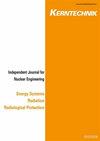不同程度核泄漏事故下沿海水域放射性核素扩散计算模型及危险区研究
IF 0.4
4区 工程技术
Q4 NUCLEAR SCIENCE & TECHNOLOGY
引用次数: 0
摘要
摘要研究不同程度核泄漏事故下沿海水域放射性核素扩散的计算模型和风险区域,有助于预测和评价放射性核素泄漏事故的后果。因此,它们在应急响应和事故缓解中发挥着重要作用。在研究的第一步,基于气候资料建立了中国沿海水域的气候水动力模型。下一步,根据实时气象数据,以气候水动力结果为边界,建立了海阳核电站近岸水域水动力模型。然后,根据海阳核电站近岸水域水动力模型的结果,建立了海阳核电站近岸水域放射性核素扩散模型,该模型采用欧拉法。采用放射性核素扩散模型,将放射性核素泄漏总放射性从1018 Bq设定为1012 Bq,每两个数量级递减一次。因此,在假定放射性核素连续5天泄漏的情况下,计算了不同级别核泄漏事故下放射性核素扩散的情景,并分析了相应的风险区域。结果表明:当放射性核素泄漏的放射性为1018 Bq时,第7天的危险区位于电站以东41 km、以南22 km、以西19 km左右;在第14天,危险区域位于电站以东65 公里,以南22 公里和以西25 公里。当放射性核素泄漏总量下降2个数量级时,危险区向东缩小约10 km ~ 20 km。当它下降到1014 Bq时,风险区域急剧减小到一个很小的区域。当它下降到1012 Bq时,几乎找不到风险区域。从流场和放射性核素浓度两个方面对该模型进行了验证。水动力结果可以很好地描述黄海冷水团、黄海暖流和潮流。不同位置的放射性变化与福岛核泄漏事故基本一致。结果表明,所采用的水动力模型和放射性核素扩散模型是可行可靠的。本文章由计算机程序翻译,如有差异,请以英文原文为准。
Study on calculation model and risk area of radionuclide diffusion in coastal waters under nuclear leakage accidents with different levels
Abstract Study on calculation model and risk area of radionuclide diffusion in coastal waters under nuclear leakage accidents with different levels can help predict and evaluate consequences of radionuclide leakage accidents. Thus they play an important role in emergency response and accident mitigation. In the first step of the study, a climate hydrodynamic model in China coastal waters was established based on the climate data. In the next step, according to the real-time meteorological data, a hydrodynamic model in coastal waters of Haiyang nuclear power station was founded using the result of the climate hydrodynamic as a boundary. Then, according to the result of the hydrodynamic model in coastal waters of Haiyang nuclear power station, a radionuclide diffusion model in coastal waters of Haiyang nuclear power station was set up, in which the Euler method was adopted. With the radionuclide diffusion model, the total leaked radioactivity of radionuclides was set from 1018 Bq to 1012 Bq with a decrease of every two orders of magnitude. Thus, scenarios of radionuclide diffusion under assumed nuclear leakage accidents with different levels were calculated and their corresponding risk area were analyzed under the assumption that radionuclides leaked for consecutive five days. The results show that when the leaked radioactivity of radionuclides is 1018 Bq, the risk area on the seventh day is about 41 km east, 22 km south and 19 km west of the power station; on the fourteenth day, the risk area is about 65 km east, 22 km south and 25 km west of the power station. When the total leaked radioactivity of radionuclides declines by two orders of magnitude, the risk area will be reduced by about 10 km–20 km in the east direction accordingly. When it declines to 1014 Bq, the risk area decreases sharply to a small area. When it declines to 1012 Bq, the risk area is barely found. This model was verified from two aspects, namely the flow field and the radionuclide concentration. Hydrodynamic results can well describe the Yellow Sea cold water mass, Yellow Sea warm current and tidal current. Changes of radioactivity in different positions are fundamentally consistent with that in Fuikushima nuclear leakage accident. It indicates the hydrodynamic model and radionuclide diffusion model in the study are feasible and reliable.
求助全文
通过发布文献求助,成功后即可免费获取论文全文。
去求助
来源期刊

Kerntechnik
工程技术-核科学技术
CiteScore
0.90
自引率
20.00%
发文量
72
审稿时长
6-12 weeks
期刊介绍:
Kerntechnik is an independent journal for nuclear engineering (including design, operation, safety and economics of nuclear power stations, research reactors and simulators), energy systems, radiation (ionizing radiation in industry, medicine and research) and radiological protection (biological effects of ionizing radiation, the system of protection for occupational, medical and public exposures, the assessment of doses, operational protection and safety programs, management of radioactive wastes, decommissioning and regulatory requirements).
 求助内容:
求助内容: 应助结果提醒方式:
应助结果提醒方式:


